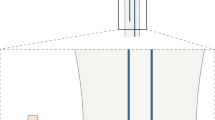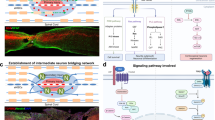Abstract
Severe spinal cord injury (SCI) leads to devastating loss of neurological function below the level of injury and adversely affects multiple body systems. Most basic research on SCI is designed to find ways to improve the unsatisfactory cellular and molecular responses of spinal cord to injury, which include an array of early processes of autodestruction and a subsequent lack of functional tissue repair. This research has brought us to the threshold of practical application along three lines of approach, derived from animal model studies: acute neuroprotection, enhanced axonal regeneration or plasticity, and treatment of demyelination. There is a growing commercial interest in this previously neglected therapeutic area.
This is a preview of subscription content, access via your institution
Access options
Subscribe to this journal
Receive 12 print issues and online access
$209.00 per year
only $17.42 per issue
Buy this article
- Purchase on Springer Link
- Instant access to full article PDF
Prices may be subject to local taxes which are calculated during checkout
Similar content being viewed by others
References
Allen, A.R. Surgery of experimental lesion of spinal cord equivalent to crush injury of fracture dislocation of spinal column: a preliminary report. JAMA 57, 878–880 (1911).
Bracken, M.B. et al. Methylprednisolone or tirilazad mesylate administration after acute spinal cord injury: 1-year follow up. Results of the third National Acute Spinal Cord Injury randomized controlled trial. J. Neurosurg. 89, 699–706 (1998).
Hall, E.D. The neuroprotective pharmacology of methylprednisolone. J. Neurosurg. 76, 13–22 (1992).
Geisler, F., Coleman, W., Grieco, G., Poonian, D. & Group, S.S. The Sygen multicenter acute spinal cord injury study. Spine 15, S87–S98 (2001).
Geisler, F.H., Dorsey, F.C. & Coleman, W.P. Recovery of motor function after spinal cord injury—a randomized, placebo-controlled trial with GM-1 ganglioside. New Engl. J. Med. 324, 1829–1838 (1991).
Rapalino, O. et al. Implantation of stimulated homologous macrophages results in partial recovery of paraplegic rats. Nat. Med. 4, 814–821 (1998).
Ramón y Cajal, S. Degeneration and Regeneration of the Nervous System (Oxford Univ. Press, London, 1928).
Caroni, P. & Schwab, M.E. Two membrane protein fractions from rat central myelin with inhibitory properties for neurite growth and fibroblast spreading. J. Cell Biol. 106, 1281–1288 (1988).
Schnell, L. & Schwab, M.E. Axonal regeneration in the rat spinal cord produced by an antibody against myelin-associated neurite growth inhibitors. Nature 343, 269–272 (1990).
Thallmair, M. et al. Neurite growth inhibitors restrict plasticity and functional recovery following corticospinal tract lesions. Nat. Neurosci. 1, 124–131 (1998).
GrandPre, T., Li, S. & Strittmatter, S. Nogo-66 receptor antagonist peptide promotes axonal regeneration. Nature 417, 547–551 (2002).
Wang, K. et al. Oligodendrocyte-myelin glycoprotein is a Nogo receptor ligand that inhibits neurite outgrowth. Nature 417, 941–944 (2002).
Liu, B., Fournier, A., GrandpPre, T. & Strittmatter, S. Myelin-associated glycoprotein as a functional ligand for the Nogo-66 receptor. Science 297, 1190–1193 (2002).
Snow, D.M., Lemmon, V., Carrino, D.A., Caplan, A.I. & Silver, J. Sulfated proteoglycans in astroglial barriers inhibit neurite outgrowth in vitro. Exp. Neurol. 109, 111–130 (1990).
Bradbury, E. et al. Chondroitinase ABC promotes functional recovery after spinal cord injury. Nature 416, 636–640 (2002).
Borgens, R. et al. An imposed oscillating electrical field improves the recovery of function in neurologically complete paraplegic dogs. J. Neurotrauma 16, 639–657 (1999).
Benowitz, L.I., Goldberg, D.E., Madsen, J.R., Soni, D. & Irwin, N. Inosine stimulates extensive axon collateral growth in the rat corticospinal tract after injury. Proc. Natl. Acad. Sci. USA 96, 13486–13490 (1999).
Cai, D. et al. Neuronal cyclic AMP controls the developmental loss in ability of axons to regenerate. J. Neurosci. 21, 4731–4739 (2001).
Qiu, J. et al. Spinal axon regeneration induced by elevation of cyclic AMP. Neuron 34, 895–903 (2002).
Lehmann, M. et al. Inactivation of Rho signaling pathway promotes CNS axon regeneration. J. Neurosci. 19, 7537–7547 (1999).
Grill, R., Murai, K., Blesch, A., Gage, F.H. & Tuszynski, M.H. Cellular delivery of neurotrophin-3 promotes corticospinal axonal growth and partial functional recovery after spinal cord injury. J. Neurosci. 17, 5560–5572 (1997).
Wirth, E.D. 3rd. et al. Feasibility and safety of neural tissue transplantation in patients with syringomyelia. J. Neurotrauma 18, 911–929 (2001).
Gledhill, R.F., Harrison, B.M. & McDonald, W.I. Demyelination and remyelination after acute spinal cord compression. Exp. Neurol. 38, 472–487 (1973).
Blight, A.R. Axonal physiology of chronic spinal cord injury in the cat: intracellular recording in vitro. Neuroscience 10, 1471–1486 (1983).
Crowe, M.J., Bresnahan, J.C., Shuman, S.L., Masters, J.N. & Beattie, M.S. Apoptosis and delayed degeneration after spinal cord injury in rats and monkeys. Nat. Med. 3, 73–76 (1997).
Shi, R. & Blight, A.R. Differential effects of low and high concentrations of 4-aminopyridine on axonal conduction in normal and injured spinal cord. Neuroscience 77, 553–562 (1997).
Potter, P.J. et al. Randomized double-blind crossover trial of fampridine-SR (sustained release 4-aminopyridine) in patients with incomplete spinal cord injury. J. Neurotrauma 15, 837–849 (1998).
Franklin, R. Remyelination of the demyelinated CNS: the case for and against transplantation of central, peripheral and olfactory glia. Brain Res. Bull. 57, 827–832 (2002).
Ramón-Cueto, A., Plant, G.W., Avila, J. & Bunge, M.B. Long-distance axonal regeneration in the transected adult rat spinal cord is promoted by olfactory ensheathing glia. J. Neurosci. 18, 3803–3815 (1998).
Blight, A.R. in Neurotrauma (eds. Narayan, R. K., Wilberger, J. E. & Povlishock, J. T.) 1367–1379 (McGraw-Hill, New York, 1996).
Wernig, A., Nanassy, A. & Muller, S. Laufband (treadmill) therapy in incomplete paraplegia and tetraplegia. J. Neurotrauma 16, 719–726 (1999).
Author information
Authors and Affiliations
Rights and permissions
About this article
Cite this article
Blight, A. Miracles and molecules—progress in spinal cord repair. Nat Neurosci 5 (Suppl 11), 1051–1054 (2002). https://doi.org/10.1038/nn939
Received:
Accepted:
Published:
Issue Date:
DOI: https://doi.org/10.1038/nn939
This article is cited by
-
MicroRNA-466c-3p exerts protective effect on neuronal apoptosis and improves functional recovery post spinal cord injury via mitochondrial apoptotic pathway
AMB Express (2020)
-
Identification and characterization of synthetic chondroitin-4-sulfate binding peptides in neuronal functions
Scientific Reports (2019)
-
An analysis of ideal and actual time to surgery after traumatic spinal cord injury in Canada
Spinal Cord (2017)
-
C-C motif chemokine ligand 20 regulates neuroinflammation following spinal cord injury via Th17 cell recruitment
Journal of Neuroinflammation (2016)
-
Nanoparticle-Delivered IRF5 siRNA Facilitates M1 to M2 Transition, Reduces Demyelination and Neurofilament Loss, and Promotes Functional Recovery After Spinal Cord Injury in Mice
Inflammation (2016)



